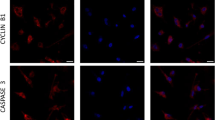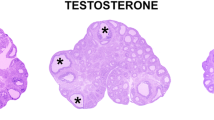Abstract
The aim of the present study was to investigate the regulation of the in vitro DNA synthesis of ovarian cells recovered from prepubertal rats 48 h after administration of pregnant mare’s serum gonadotrophin alone (granulosa cells) or followed by human chorionic gonadotrophin (luteal cells). Isolated granulosa cells were cultured in serum-free medium, different stimuli added for periods of 48 h, and3H-thymidine incorporation was measured. Both follicle-stimulating hormone (FSH) and luteinizing hormone (LH) inhibited3H-thymidine incorporation by cultured granulosa cells in a dose-dependent manner (FSH: 10, 100, 200 ng/mL-26, 41, 49% inhibition, respectively; LH: 0.1, 1, 10 ng/mL=11, 37, 75% inhibition, respectively). On the other hand, estradiol was found to stimulate3H-thymidine incorporation in granulosa cells (Estradiol: 5, 50, 500 ng/mL=17, 37, 76% stimulation, respectively). In luteal cells, the rate of basal3H-thymidine incorporation was very low (granulosa cells: 2560±310; luteal cells: 661±92 cpm/100,000 cells) and not modified by any stimulus. To determine the possible production of an inhibitory growth factor by the early corpus luteum,3H-thymidine incorporation by granulosa cells was assessed in the presence of 10% conditioned media (CM) recovered from luteal cell cultures. A marked inhibition both in basal and estradiol-stimulated3H-thymidine incorporation was observed (74 and 76% of inhibition, respectively). Results suggest that an inhibitory growth factor produced by luteal cells after luteinizing gonadotrophin stimulus could be involved in the differentiation of growing follicles to corpus luteum.
Similar content being viewed by others
References
Auletta, F. J. and Flint, A. P. F. (1988).Endocr. Rev. 9, 88–105.
Keyes, P. L. and Wiltbank, M. C. (1988).Ann. Rev. Physiol. 50, 465–482.
Hsueh, A. J. W., Adashi, E. Y., Jones, P. B. C., and Welsh, T. H. Jr. (1984).Endocr. Rev. 5, 76–127.
Bendell, J. J. and Dorrington, J. (1991).Endocrinology 128, 2663–2665.
Peluso, J. J., Delidow, B. C., Lynch, J., and White, B. A. (1991).Endocrinology 128, 191–196.
Hammond, J. M., Barañao, J. L. S., Skaleris, D. A., Knight, A. B., Romanus, J. A., and Rechler, M. M. (1985).Endocrinology 117, 2553–2555.
Voutilainen, R. and Miller, W. (1987).Proc. Natl. Acad. Sci. USA 84, 1590–1594.
Hirshfield, A. (1989). InGrowth Factors and the Ovary. Plenum: New York.
Bley, M. A., Simón, J. C., Estévez, A. G., Jiménez de Asúa, L., and Barañao, J. L. (1992).Endocrinology 131, 1223–1229.
Bley, M. A., Simón, J. S., Saragüeta, P. E., and Barañao, J. L. S. (1991).Biol. Reprod. 44, 880–888.
Roy, S. K. and Greenwald, G. S. (1991).Biol. Reprod. 44, 889–896.
Zhou, J., Chin, E., and Bondy, C. (1991).Endocrinology 129, 3281–3288.
Yong, E. L., Baird, D. T., Yates, R., Reichert, L. E. Jr., and Hillier, S. G. (1992).J. Clin. Endocrinol. Metab. 74, 842–849.
Maruo, T., Ladines-Llave, C. A., Samoto, T., Matsuo, H., Manalo, A. S., Ito, H., and Mochizuki, M. (1993).Endocrinology 132, 924–931.
Dain, L. B., Stein, P., Krimer, A. R. D., Asch, R. H., Polak de Fried, E., Charreau, E. H., and Tesone, M. (1991).Fertil. Steril. 55, 1093–1098.
Chaffkin, L. M., Luciano, A. A., and Peluso, J. J. (1992).J. Clin. Endocrinol. Metab. 75, 1404–1408.
Bomsel-Helmreich, O., Guogeon, A., Thebault, A., Saltarelli, D., Milgram, E., Frydman, R., and Papiernik, E. (1979).J. Clin. Endocrinol. Metab. 48, 686–694.
Dain, L. B., Bley, M. A., Barañao, J. L., and Tesone, M. (1993).Mol. Reprod. Dev. 36, 159–163.
Greenwald, G. S. and Roy, S. K. (1994). InThe Physiology of Reproduction. Knobil, E. and Neill, J. D. (eds.). New York: Raven, pp. 629–724.
Peluso, J. J., Steger, R. W., and Hafez, E. S. E. (1976).J. Reprod. Fertil. 47, 55–58.
Zarrow, M. X. and Wilson, E. D. (1961).Endocrinology 69, 851–855.
Hirshfield, A. (1989).Biol. Reprod. 34, 229–235.
Amsterdam, A. and Rotmensch, S. (1987).Endocr. Rev. 8, 309–337.
Yong, E. L., Baird, D. T., and Hillier, S. G. (1992).Clin. Endocrinol. 37, 51–58.
Bradbury, J. T. (1961).Endocrinology 68, 115–120.
Merk, F. B., Botticelli, C. R., and Albright, J. T. (1972).Endocrinology 90, 992–1007.
Pencharz, R. I. (1940).Science 91, 554,555.
Stumpf, W. E. (1969).Endocrinology 85, 31–37.
Tetsuka, M., Whitelaw, P. F., Bremner, W. J., Millar, M. R., Smyth, C. D., and Hillier, S. G. (1995).J. Endocrinol. 145, 535–543.
Hirai, M., Hirata, S., Osade, T., Hagihara, K., and Kato, J. (1994).J. Steroid Biochem. Mol. Biol. 40, 1–7.
Wilson, C. A., Ter Haar, M. B., Bonney, R. C., Buckingham, J., Dixson, A. F., and Yeo, T. (1983).J. Endocrinol. 99, 63–76.
Guerrero, H. E., Stein, P., Asch, R. H., Polak de Fried, E., and Tesone, M. (1993).Fertil. Steril. 59, 803–809.
Bornstein, M. B. (1958).Lab Invest. 7, 134–137.
Saragüeta, P., Krimer, A. R. D., Charreau, E. H., and Tesone, M. (1989).J. Steroid Biochem. 32, 393–397.
Lowry, O. H., Rosebrough, N. J., Farr, A. L., and Randall, R. J. (1951).J. Biol. Chem. 193, 265–275.
Author information
Authors and Affiliations
Corresponding author
Rights and permissions
About this article
Cite this article
Andreu, C.V., Buscaglia, C.A., Parborell, F. et al. Regulation of ovarian follicle differentiation in gonadotrophin-stimulated rats. Endocr 6, 145–151 (1997). https://doi.org/10.1007/BF02738957
Received:
Revised:
Accepted:
Issue Date:
DOI: https://doi.org/10.1007/BF02738957




